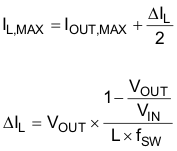SLVSB70C October 2013 – January 2021 TPS62085 , TPS62086 , TPS62087
PRODUCTION DATA
- 1 Features
- 2 Applications
- 3 Description
- 4 Revision History
- 5 Device Options
- 6 Pin Configuration and Functions
- 7 Specifications
- 8 Detailed Description
- 9 Application and Implementation
- 10Power Supply Recommendations
- 11Layout
- 12Device and Documentation Support
Package Options
Mechanical Data (Package|Pins)
- RLT|7
Thermal pad, mechanical data (Package|Pins)
Orderable Information
9.2.2.4 Inductor Selection
The main parameter for the inductor selection is the inductor value and then the saturation current of the inductor. To calculate the maximum inductor current under static load conditions, Equation 4 is given.
Equation 4. 

where
- IOUT,MAX = Maximum output current
- ΔIL = Inductor current ripple
- fSW = Switching frequency
- L = Inductor value
TI recommends choosing the saturation current for the inductor 20% to 30% higher than the IL,MAX, out of Equation 4. A higher inductor value is also useful to lower ripple current but increases the transient response time as well. The following inductors are recommended to be used in designs.
Table 9-4 List of Recommended Inductors
| INDUCTANCE [µH] | CURRENT RATING [A] | DIMENSIONS L × W × H [mm3] | DC RESISTANCE [mΩ typical] | PART NUMBER |
|---|---|---|---|---|
| 0.47 | 6.6 | 4 × 4 × 1.5 | 7.6 | Coilcraft XFL4015-471 |
| 0.47 | 6.7 | 3.2 × 2.5 × 1.2 | 23 | Murata DFE322512F-R47N |
| 1 | 5.1 | 4 × 4 × 2 | 10.8 | Coilcraft XFL4020-102 |